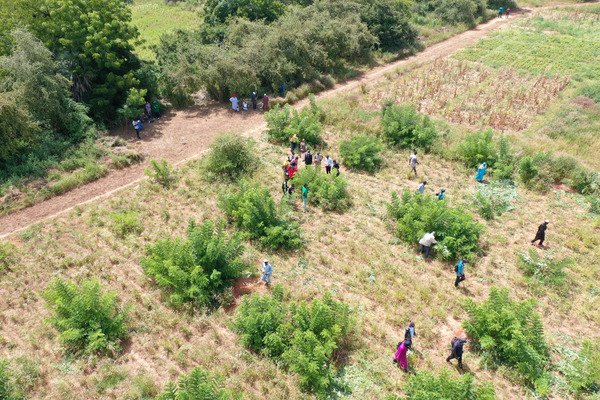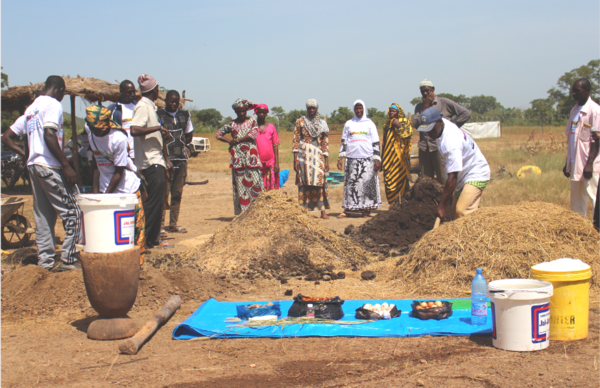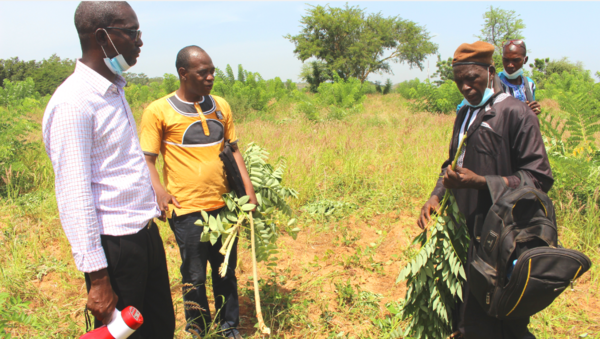Approximately 60 km from Mali's capital in Koulikoro, you find the Rural Polytechnic Institute - IPR/IFRA - where the first day of the second dissemination event starts.
Day 1 - Famers visit and drone imaging
The visit begins at the field of Adama Diarra, who has been growing sorghum for years. This is one of the test fields of the SustainSahel project, where several treatments are used. The farmer has found that crops grown with popularised mineral fertilisers are much more profitable. However, it is not cheap, as fertiliser is expensive, so he has to fall back on biomass, which enriches and protects the soil. Piliostigma and Guiera are also effective in the plots where they are used as treatments, and the crop is very profitable. As for Gliricidia Sepium, it is not prevelant on their land.
It is important to show producers the yield of crops through images. A drone is often used to do this. The images taken will allow an observational study to be made to see the evolution of the crops. So, during this first day, IPR pilots were trained to use a drone.
Day 2 - Visit to IPR station and video dissemination
On the second day, it was the farmers' day at the IPR station. The producers accompanied by researchers and partners visited the trial fields where three practices were presented:
- Biomass transfer with three woody species used: Guiera Senegalensis, Piliostigma Reticulum and Gliricidia Sepium used on Sorghum crops to see its effect,
- Cultural association with rotation on Faidherbia Albida to see the effect of crops on woody plants,
- Alley cropping, two lines of Gliricidia Sepium and between each row, cowpea was cultivated.
During the visit, the researchers let the farmers cut branches of Gliricidia, because it is a foreign plant that is nevertheless very popular with the farmers. If you don't have the seed, you just have to plant a branch to propogate a whole tree.
Gliricidia Sepium is a leguminious plant, meaning it has the ability to fix atmospheric nitrogen in the soil. Producers use it as a mulch to fertilise the soil, one farmer explained the process: "You cut the leaves and spread them on the ground, they decompose more quickly. When you use a tonne of this species in a month, it decomposes and enriches the soil. Farmers also use it as fodder for their livestock, they take the leaves, put them in the shade, and once they are dry, remove the leaves and feed that to the livestock."
Dramane Diarra, a farmer from the village of Mafia in Koulikoro, considers Gliricidia to be a multi-purpose tree. He uses it in his agricultural production to improve the fertility of his soils and the yield of his crops, he explains: "In my plots, I place the leaves between the rows of millet, maize and sorghum crops, the leaves decompose and mineralise and the crops benefit. For the past five years, I have had a field of Gliricidia in my plot every year, I use the leaves as mulch."
It is important to disseminate these kinds of practices. Dramane's ambition is to spread this mulching technique throughout Mali, and he has already started to raise awareness among farmers in his village and the surrounding area about the benefits of Gliricidia for crops and livestock.
The producers had some concerns about the specifics of the technique, e.g., biomass transfer period, the quantity to be used for each crop and the period of application, among others. However, they welcomed the initiative, which is why they wanted to participate in this farmers' day, as they feel that these are practices that they can easily carry out in their fields. With the high cost of fertiliser in recent years, these innovative techniques are an alternative.
As in Senegal and Burkina Faso, micro SD cards were distributed to producers. These cards contain nine learning videos in the Bambara language on integration, cultivation, shrubbery and animal husbandry. They were produced by Access Agriculture > see 'Farmer-to-farmer training videos translated into local languages' for more information.
Agroecological farmers' fair
This dissemination event ended with the second edition of the agroecological farmers' fair in the commune of Ouelessegou and Tamala, organised by AMSD, the Malian Association for Solidarity and Development, in the framework of the SustainSahel project. The aim of this fair is to promote farmers' knowledge and agroecological and agroforestry practices, thus enabling producers and breeders to integrate certain agroecological practices.
During this day, the women of Ouelessegou and Tamala were trained in the preparation an organic fertiliser called Bokachi. "If producers are to make an agroecological transition, they must be accompanied and trained in alternative practices, such as the preparation of organic Bokachi fertiliser and the preparation of bio-pesticides to fight against insect attacks and others and to fertilise the soil", explains Hamidou Almamy Diawara, President of AMSD.
The AMSD association wants to ensure that agroforestry and agroecology can be integrated in a circular fashion until producers can understand that climate change is a handicap for sustainable development. By integrating these concepts and practical solutions to feed people with components that are adapted to their environment and accessible to all.
Given the geographical situation, some producers thought that it was not appropriate to develop market gardening and cereal production in Ouelessegou and Tamala. The AMSD has shown the opposite: "Whatever the geographical situation, people must develop adaptation techniques, and this is what we have shared with the producers. In addition to agroforestry and agroecology, we have developed models of organic agriculture, fish farming, market gardening, and nurseries for reforestation campaigns for each winter season," says Almamy Diawara.
The AMSD intends to popularise these good practices, as the association believes that they will enable the population to fight against poverty and reduce the negative impacts of climate change in these areas.
Written by: Ndeye Fatim Lô, Communication specialist at CSE.
Further information
Related news items
Dissemination events in Senegal and Burkina Faso - October 2022
Farmer-to-farmer training videos translated into local languages - September 2022






 tap and then scroll down to the Add to Home Screen command.
tap and then scroll down to the Add to Home Screen command.